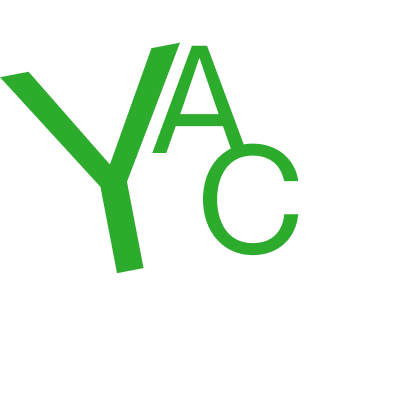Chris Alton
Interview by Harry Meadley
-
Published October 2018
-

English Disco Lovers (EDL), Cambridge Graffiti, Photograph, 2013
I’m not necessarily sure if I still qualify as a young artist anymore, but in thinking about interviewing you for this I revisited my interview on here from a few years ago. I was quite startled at how much my opinions and thinking about art making have changed since that time. I imagine I may not be alone in this experience, so I thought I might start off by asking how you feel your thinking or approach to art making may have changed in recent years?
When I started the second year of my BA, I promised myself that I wouldn’t make anything that I couldn’t carry; couldn’t store; or would have to just throw away. I’d ended my first year with a vast volume of work; paintings, sculptures, drawings, prints (all of which were very big, very bad versions of work by other artists). They just ended up in a skip. That wastage of material didn’t make sense to me, so I set myself some parameters, which ended up shaping the work I made for almost 4 years.
The first significant project that was birthed by my private manifesto for carriable, storable art was English Disco Lovers (EDL) (2012-15). Materially, the work existed as a shared idea, spread by websites, social media accounts, photos, videos, memes, news articles and other online/digital media. Sometimes it would manifest offline; as street protests, disco nights and other events. Whilst my decision was initially a practical one, I think I was motivated by other underlying factors; the ideas that I wanted to approach in my work were better suited to mediums outside the established ‘norms’ of art: painting and sculpture. In addition, I didn’t have the money to produce (then keep producing) that kind of work, without selling it. Under those conditions, I could have quickly found myself trying to play to some vague notion of a market. I didn’t want that. If anything, I went in the opposite direction; making work that was free/cheap to produce, difficult to pin down, and often existed in endless multiples. I went on to make a number of games and interventions, many of which were open source ideas. For instance; a shared interest in the bounce (2014), non-competitive ping pong, played against the surface of a Camden Bench; and hard hand to hold (2014), a diagram that demonstrates all the knots necessary to hang a rope swing from a public sculpture.
More recently, I’ve broken my ‘must be carriable and storable’ rule in a somewhat excessive fashion. In 2017, I undertook a participation-led commission for The National Trust and produced a neoclassical treehouse-pavilion-folly, which weighs over a tonne. I don’t know if this is indicative of my thinking or approach to art making changing, as opposed to the conditions that I’m working under changing. The things that I make (and make happen) still begin with an idea, before they find a form. They also remain contingent on the amount of money available to me (which is still very little, unless I’m fortunate enough to have been commissioned). Like most artists, I’m walking the line between making work and paying my rent, so there’s bound to be some slippage between the two.
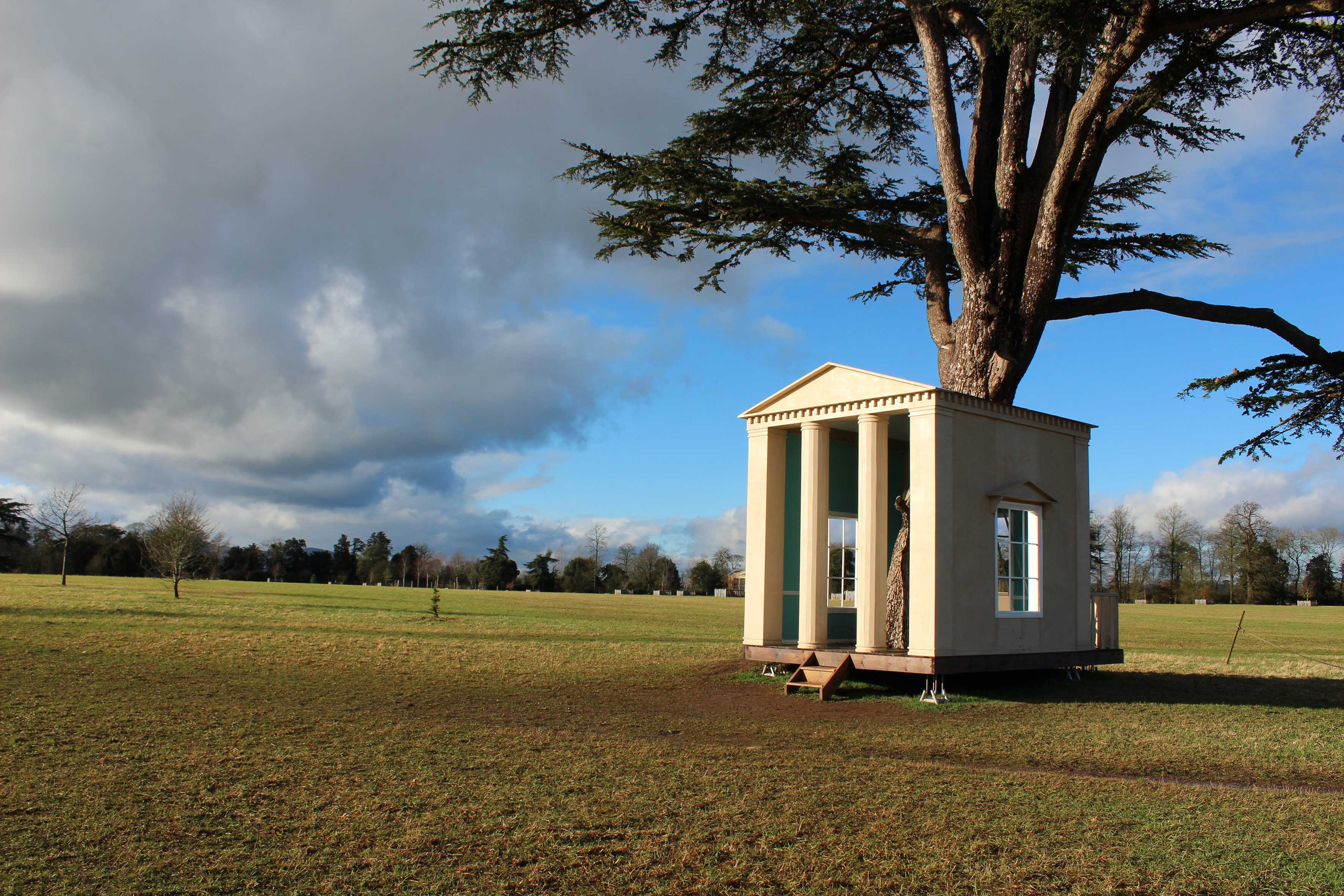
Adam Speaks (With New Mouths), Plywood, timber, steel, cedar shingles, paint, varnish, 400x650x800cm approx, 2017
I often wonder about the impulse to self-impose rules or parameters onto art making – to have a ‘code’ let’s say. Being slightly conscious of your involvement with Quakerism, and your work having what could be described as quite a conscientious nature; I would be interested in whether you also have a moral code, as much as the practical one you outlined?
I’ve been a Quaker my whole life, so I think it’s inevitable that my practice echoes those values [https://www.quaker.org.uk/about-quakers/our-values]; not that I’ve imbibed them unquestioningly. Quakers like to say, ‘come to Quaker meeting and have all your answers questioned’, so I think it’s fostered in me the will to engage with the world in a critical manner; although I think it’s important to do so in a way that makes space for joy, hope, and optimism.
Given that we’re talking about faith and religion, could I suggest a word other than ‘moral’? It’s a bit uncomfortable for me, as it could suggest a rigid standpoint; one derived from the so-called ‘word of God’. Quakers tend to use the word ‘values’, it’s humbler and reflects a willingness to be guided by our experiences and those of others. Quakers - broadly speaking - are willing to admit when they’re wrong; to learn and adapt to our changing world; as well as actively engaging in effecting change.
Whilst my work carries the inflection of Quaker values, I try to avoid being didactic in their communication. The ambiguity of art oftens means it’s not best suited to telling people what to think or convincing them of a particular standpoint. It might sound like a cliché, but art is often a conduit for questions rather than answers; a mode of disruption or a means for grappling with that which we don’t fully understand.
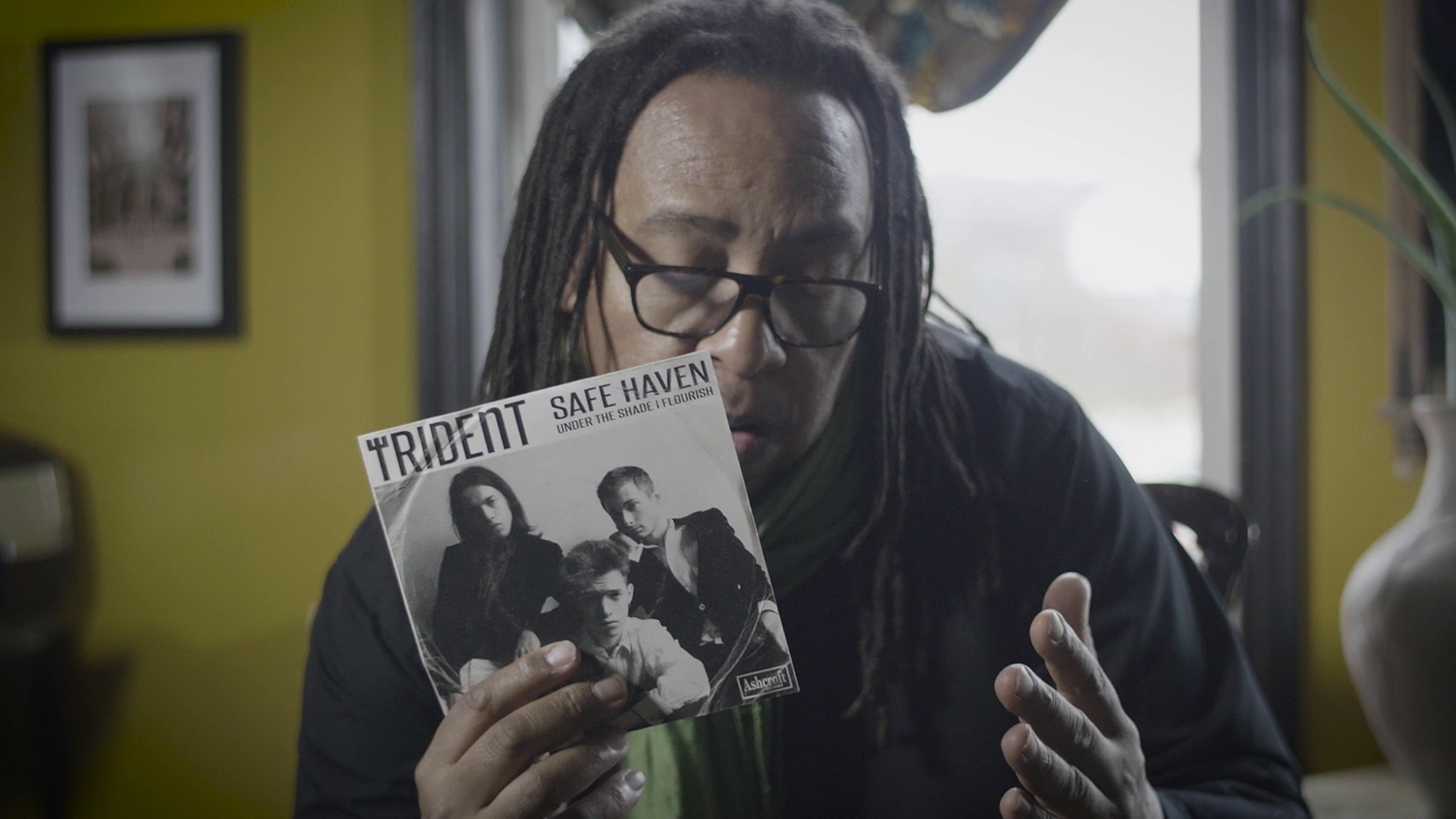
Still from Under the Shade I Flourish, HD film, 29 minutes 37 seconds, 2016
I think there is a standpoint though, or at least a standpoint that places itself in ‘opposition to’. That opposition may be being approached in a slightly less direct way, but it seems you often have quite a clear - to use a very simplified and maybe over the top term: enemy. There is evidently joy, hope and optimism generated from your work - not something easily done - which could in a sense place you as a 'goodie'. Quite frequently within the work, or the work’s subject matter, there are clear 'baddies'. I guess I wonder when there are (unfortunately) so many baddies out there in the world, what makes you pick your targets?
My general approach is a gradual collection and massing of ideas and reference points until they converge in interesting ways; often that point of convergence is the so-called ‘baddie’. Ultimately, I take my time and rely upon chance. It’s difficult to force.
One project began when I came face-to-face with a double-life-size bust of the former Tory peer Michael Ashcroft. It was a totally chance encounter, but I was interested in this overblown display of power/status. Through subsequent investigation, I found that he would be an interesting conduit for talking about the interconnected nature of; tax avoidance, soft power and British colonialism, via a rhythm ‘n’ blues band called Trident, which he’d managed in the 1960s. The project, titled Under the Shade I Flourish (2015-16), grew into an elaborate alternative-history project, encompassing; a pseudo-documentary, an album, a radio show, a fan-blog, posters, photographs and more.
When picking my targets, I think I’m looking for; people, organisations, objects, spaces, or behaviors that are unjust; that possess power, but cloak that injustice and/or power in such a way that it is normalised. In foregrounding these things, I hope to destabilize them in some way. In many ways, having a ‘baddie’ just makes this process easier; a foil allows you to draw comparisons. The satirical and subversive nature of a lot of my work also relies upon having a known point of opposition to satirise/subvert. But I hope that my work does more than simply present dichotomies. Recently, I’ve been focusing more on the ideologies and systemic issues that give rise to these ‘baddies’.
My billboard commission for Spit & Sawdust addresses a less explicit foe, or at least one that’s harder to pin down, more diffuse and difficult to name. Crudely Plucking the Strings (2018) is a reworking of much older image; a woodcut depicting the 1607 flood of the Bristol Channel. My version places Hinkley Point C at the epicentre of the flood. The yet to be completed nuclear power station, which sits on the southern bank of the Bristol Channel might seem like the clear enemy. However, the billboard and accompanying film are not only concerned with the collusion of various powers (government, non-sustainable energy production and arms manufacturing), but also with the stories that we - as a society - tell ourselves; and how these stories curtail our ability to reimagine our world.
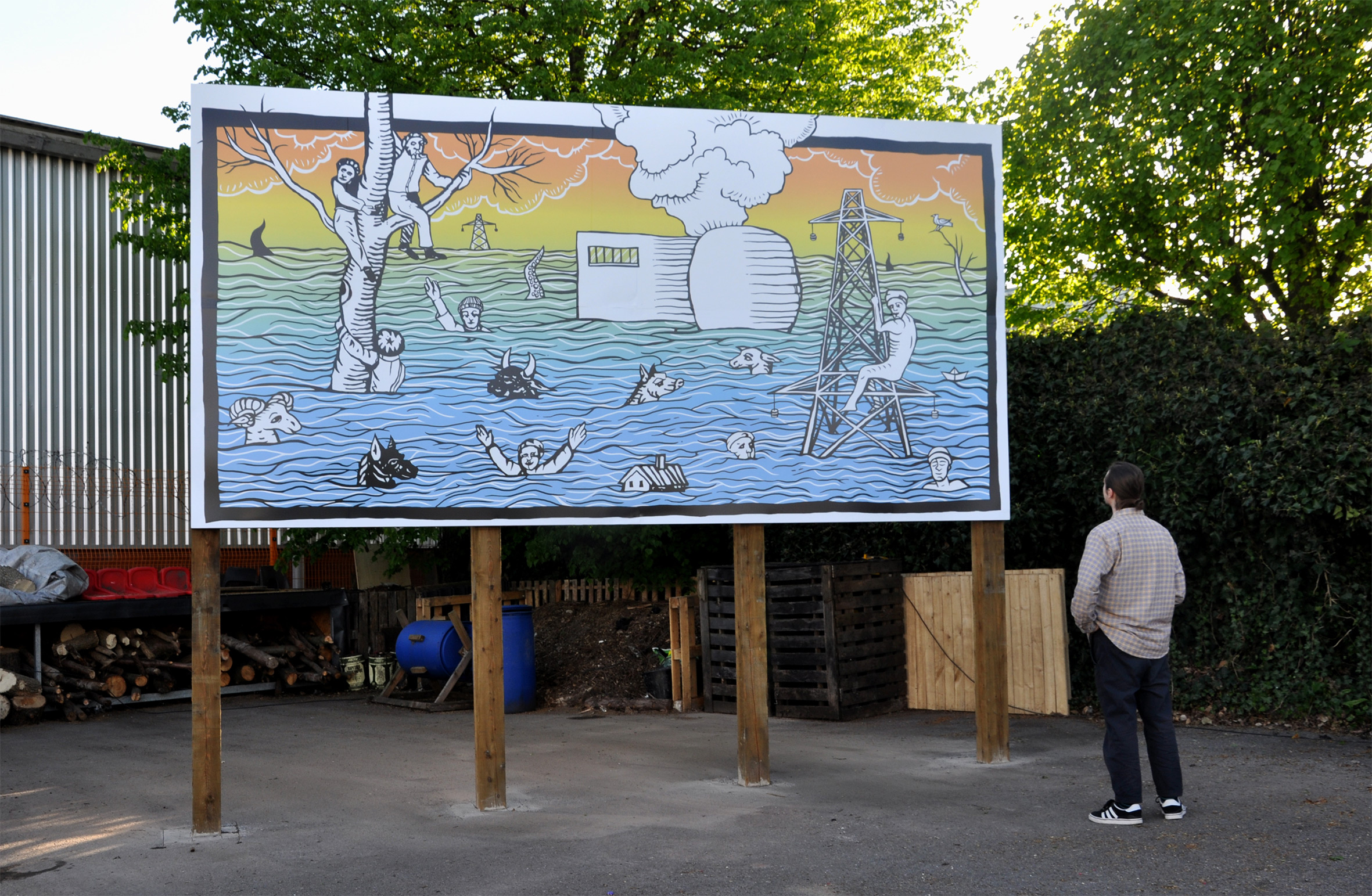
Crudely Plucking the Strings, Vinyl billboard, 600x300cm, 2018 (photo by Freya Dooley)
It’s interesting you mention Spit & Sawdust, as it has quite the unique status of being both a skatepark and an art space. Knowing that both you and I share the, maybe slightly less unique, status of being both artists and skateboarders; I would imagine we share a similar experience in terms of the influence skateboarding has had on our artistic thinking; particularly in relation to failure; i.e. becoming accustomed to and accepting of endless failure in the pursuit of progression. I would be interested to hear about what you see as some of your artistic failures - or even failings?
Each of my projects could almost be described as the the final success at the end of a stream of failures. When I’m working on something new, my sketchbooks and notebooks fill up with the same set of notes and drawings, repeating over and over again. Each time there are minor developments; new ideas and connections begin to emerge until things finally click into place. Sometimes I’ll pursue trains of thought that turn out to be dead ends; but with each dead end that is discovered, one better understands the layout of the maze.
There are various unresolved projects that I’m still working on; ideas that are yet to find the right form. Mostly, they’re projects that I’m yet to spend enough time with, or that I’m not yet equal to. For instance, I’ve been trying to develop a project about a family story, which my Grandad first told me almost 4 years ago. It concerns a German soldier, who shot to wound rather than to kill. I see it as an opportunity to explore other stories regarding soldiers shooting to wound rather than kill, firing high, and even tampering with their own weapons. Stories that do the opposite of glorifying war and violence are of great interest to me. That idea sits in the back of my head; gently growing. Eventually it may become something. Until then I’ll carry it.
There are of course works that never make it. Ones that have been made, but never shown; ones that were once exciting ideas, but now gather digital dust as files on my laptop. They may be excavated one day, although some are so bad that I sincerely doubt it.
My artistic failings? I think that I have a tendency to over-intellectualise, which can act as a veil that cloaks the work; or a prop that supports it. I can also be over-reliant on references, which others may not be familiar with. This tendency can become a barrier to fully understanding the work; I can’t expect everyone to know the etymology of ‘discotheque’ or that the Bristol Channel was flooded by a suspected tsunami in 1607. Another failing, which I’ve only recently become aware of, is over exhibiting. Placing too much focus and weight on making new shows has been detrimental to the development of my work. In failing to prioritise and trying to do ‘everything’, I haven’t always been able to give the work the time that it needed; subsequently I failed to make the best work that I could. I'm not against exhibiting, I've just overdone it. Since this realisation, I’ve resolved to do less, but to do it better.
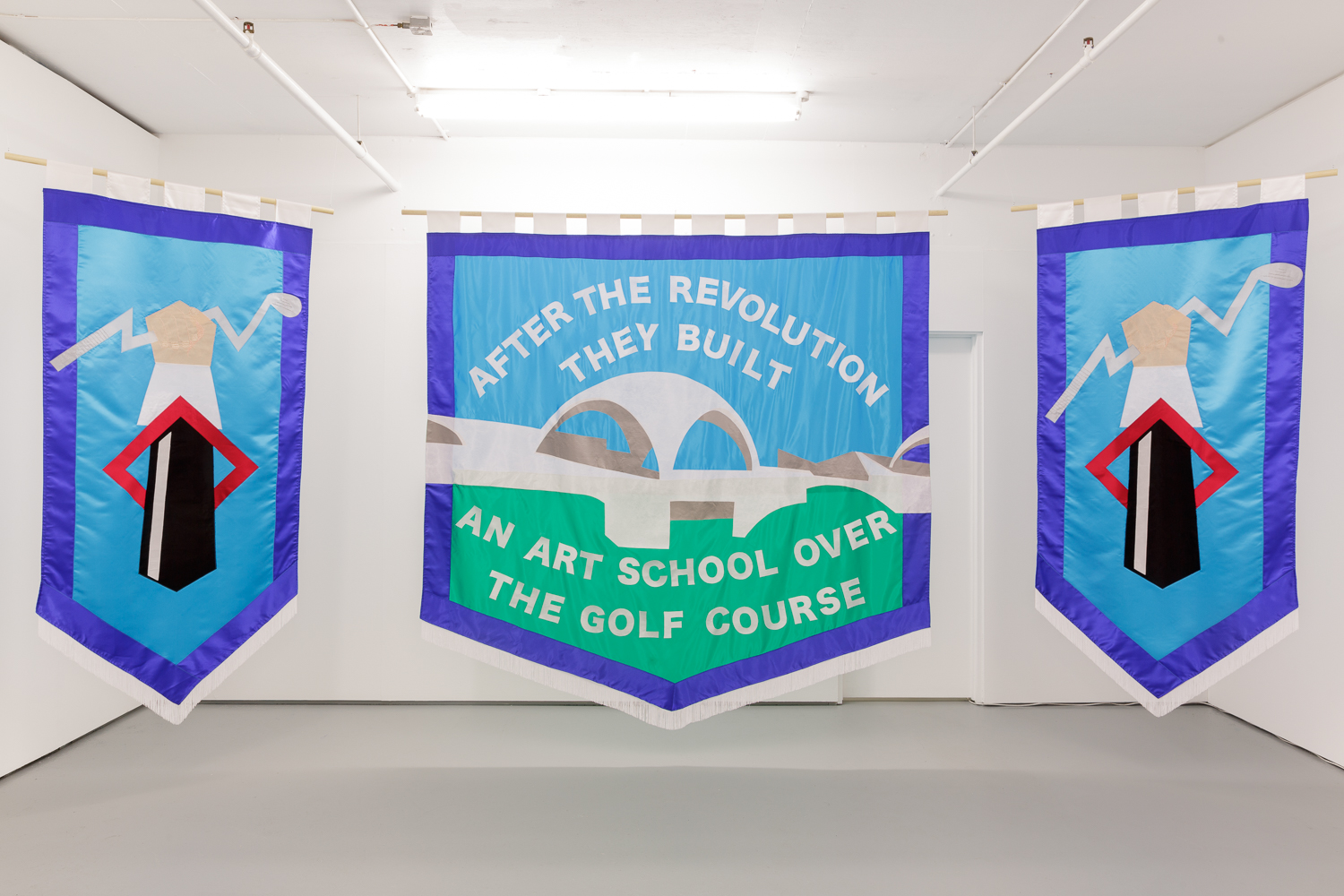
After the Revolution They Built an Art School Over the Golf Course, Textiles, 230x115, 230x250, 230x115cm, 2017 (photo by Tim Bowditch)
Ah yeah, it definitely took me longer than I would have liked to start prioritising works and/or projects over exhibitions. It’s a difficult balance though. You’ve got quite a few shows coming up though no?
I suppose so, although I've already made the works for them, which takes a lot of the pressure off! I have a new work in Survey, a group exhibition which has just opened at Jerwood Space in London. It will later tour to g39 in Cardiff, Bluecoat in Liverpool, and BALTIC in Gateshead. I also have a work in Bloomberg New Contemporaries, which opens at South London Gallery this December.
Exhibitions aside, I'll be starting a residency with Eastside Projects this November, which is an amazing opportunity with regard to prioritising the work over a sustained period of time. I’ve also recently been appointed as the Head of Public Realm Projects at Turf Projects, an artist-led space in Croydon. I’ll be leading on the curation and delivery of a series of text-based poster works, which Turf commission for public spaces in Croydon.
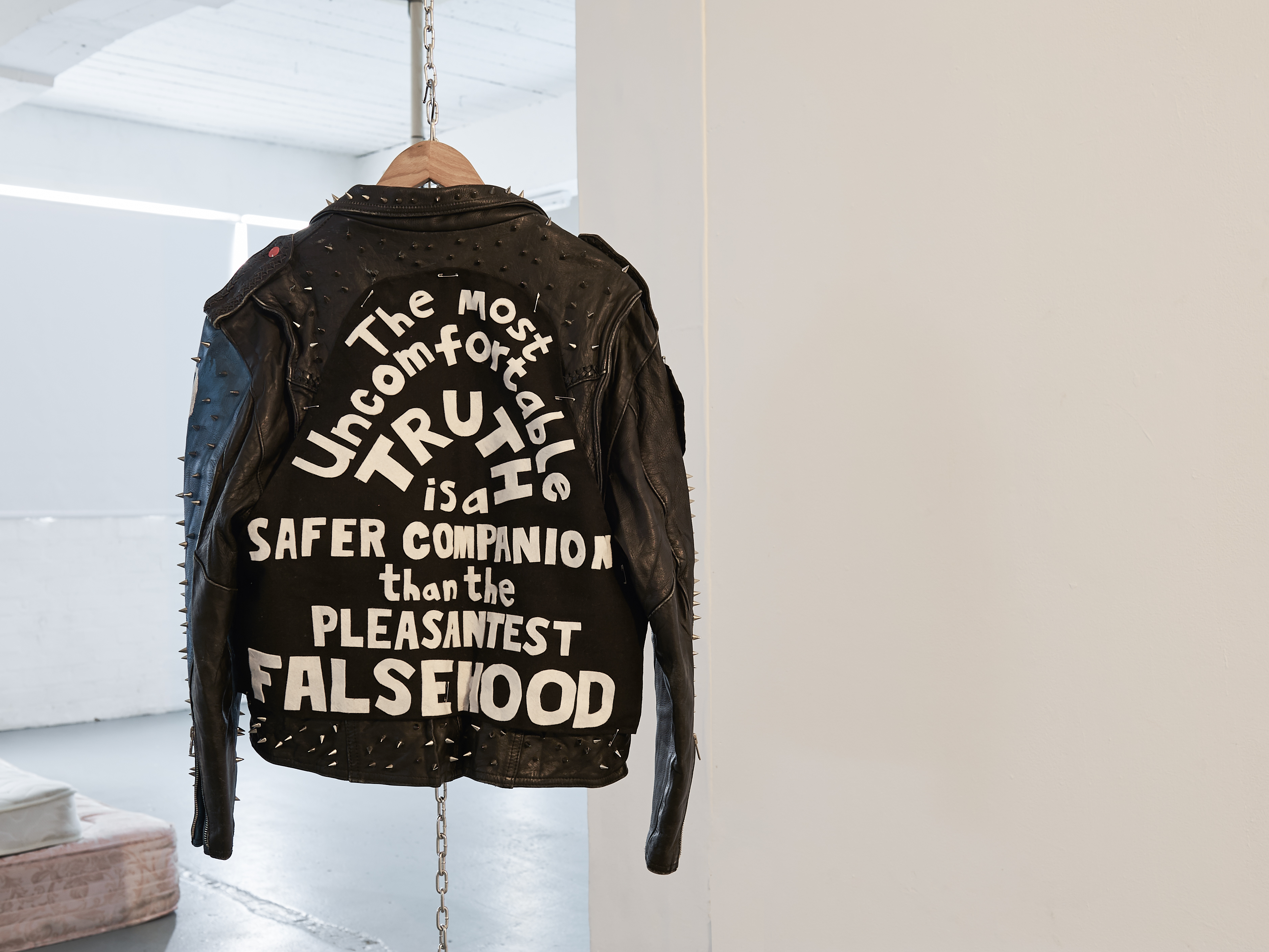
Still Anarchy, Customised leather jacket, 2018, 65x70cm approx, June 2018 (photo by Patrick Dandy)
-
Chris Alton was born in 1991, in Croydon, UK. He lives and works between Croydon and Folkestone. He was a participant in Syllabus III (2017-18). Commissions and exhibitions include; Bloomberg New Contemporaries, Liverpool John Moore University (2018) & South London Gallery (2018-19); Survey, Jerwood Space, London (2018); The Billboard, Spit & Sawdust, Cardiff (2018); Adam Speaks, The National Trust, Croome, Worcestershire (2017); You're Surrounded by Me, Turf Projects, Croydon (2017); and Under the Shade I Flourish, xero, kline & coma, London (2016).
-
chrisalton.com
-
If you like this why not read our interview with Michaela Cullen
-
© 2013 - 2018 YAC | Young Artists in Conversation ALL RIGHTS RESERVED
